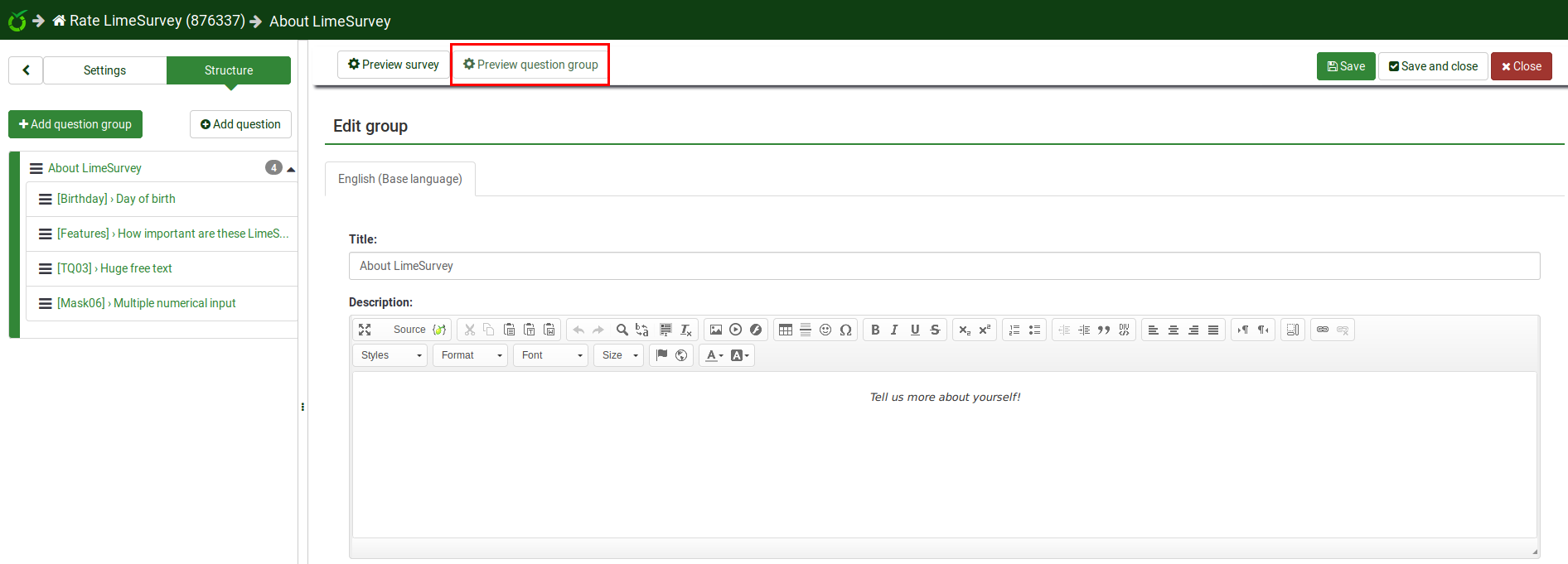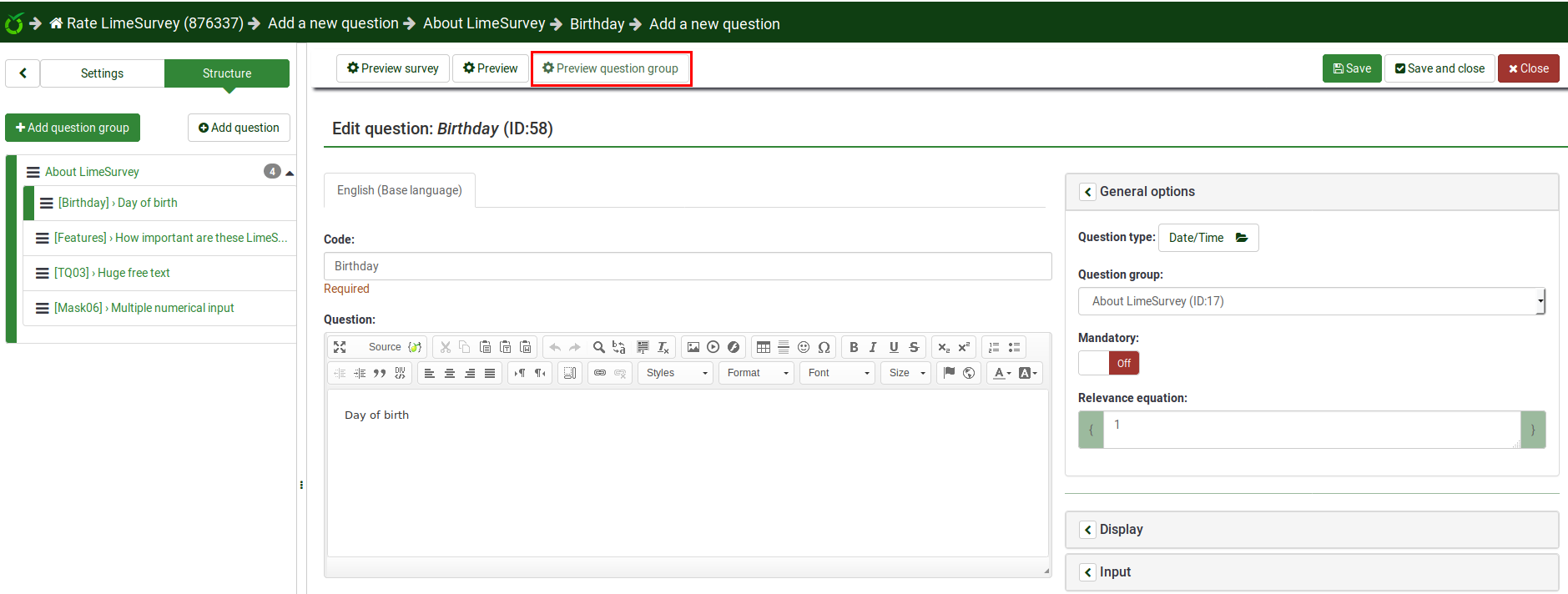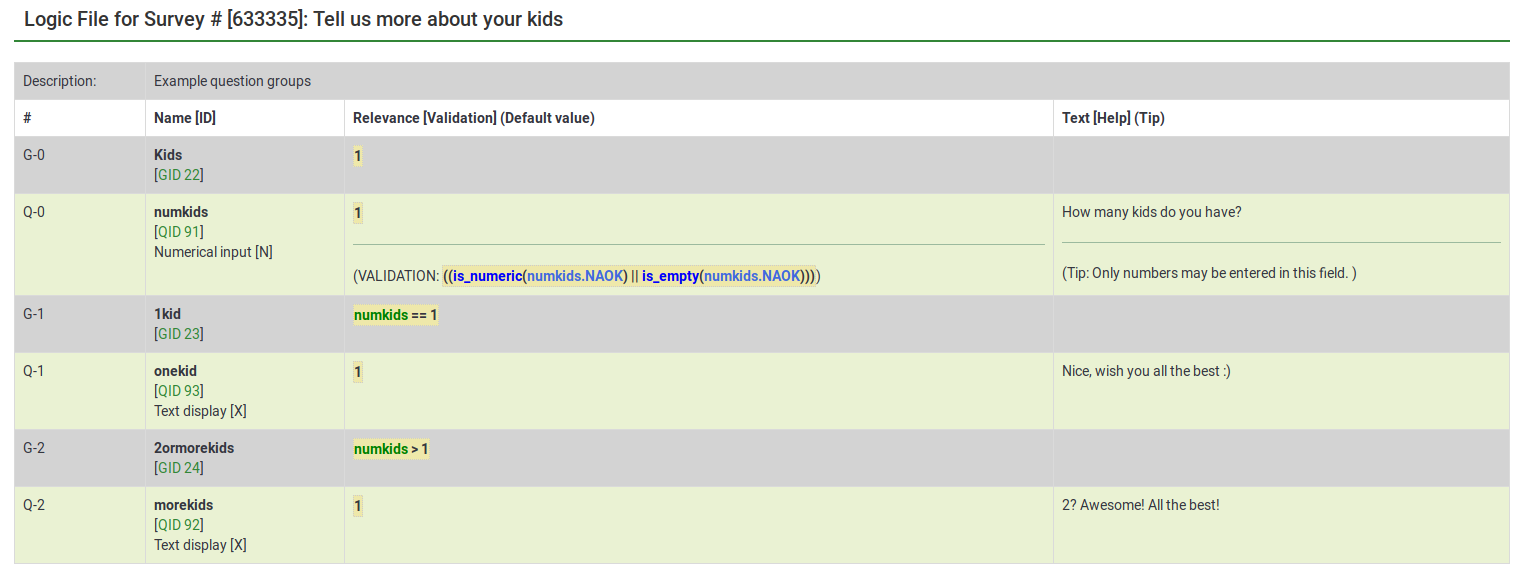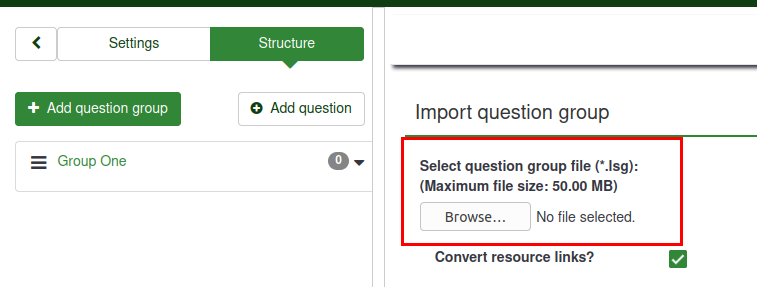Gruppi di domande - introduzione
From LimeSurvey Manual
Crea gruppo di domande
I gruppi sono un ottimo modo per organizzare i tuoi sondaggi inserendoli in categorie (gruppi). Il modo in cui classifichi i tuoi sondaggi/gruppi dipende completamente da te.
Per aggiungere gruppi di domande alla tua indagine:
(1) Dalla scheda sondaggio struttura del tuo sondaggio fai clic su +Aggiungi gruppo di domande.
File:Opzione 2 - crea un gruppo di domande.png
Dopo aver fatto clic su Aggiungi gruppo di domande, verrà visualizzato il pannello Aggiungi gruppo di domande.
(2) Completare i campi obbligatori.
campi Aggiungi gruppo di domande
- Titolo: Digita in questa casella il nome che vuoi dare al gruppo di domande;
- Descrizione: Questo campo permette di pubblicare una nota esplicativa per qualsiasi serie di domande. Se aggiungi una descrizione, verrà presentata insieme al sondaggio prima di iniziare una qualsiasi delle domande in quel gruppo. Se non viene aggiunto alcun testo, i partecipanti pubblici passeranno semplicemente direttamente alle domande del sondaggio. Puoi utilizzare l'editor HTML per includere immagini, testo formattato, ecc. a tuo piacimento;
- Gruppo di randomizzazione: Per iniziare a randomizzare un gruppo di domande, inserisci una stringa nel campo come randgroup1. Dovrai inserire la stessa stringa in tutti i gruppi di domande che desideri randomizzare e che appariranno in ordine casuale quando parteciperai al sondaggio. Solo i posti all'interno dello stesso gruppo verranno scambiati casualmente!
- Equazione di rilevanza: È possibile impostare una "equazione di rilevanza" in questo campo per il gruppo con l'aiuto di ExpressionScript. Questo è utile per "looping" o altri casi in cui si ripetono contenuti simili più volte. Ad esempio, supponi di voler porre la stessa serie di domande di follow-up per ogni bambino in una famiglia e di aver chiesto quanti bambini ci sono tramite una domanda chiamata numKids. Quindi, per ogni gruppo di domande di follow-up dovresti usare equazioni di rilevanza (che raccolgono dati sul terzo figlio) come: numKids == 3;
Puoi creare quanti gruppi vuoi!
Aggiungi barra degli strumenti del gruppo di domande
Troverai le seguenti opzioni nella barra degli strumenti in alto:
- Visualizza/Esporta: Questa funzione è utilizzata per esportare l'intero sondaggio in diversi formati.
- Partecipanti al sondaggio: Facendo clic su questo pulsante, l'amministratore del sondaggio verrà reindirizzato al suo [ [Partecipanti sondaggio|tabella partecipanti sondaggio]].
- Risposte: Se il sondaggio è attivo, il pulsante diventa visibile. Ti offre l'accesso alla tabella delle risposte.
- Importa un gruppo: Oltre ai due modi menzionati sopra, è anche possibile aggiungere nuovi gruppi di domande tramite importa funzione di gruppo.
Importa un gruppo di domande
Puoi anche importare un gruppo di domande (formato file .lsg) precedentemente esportato da un sondaggio LimeSurvey.
(1) Dalla scheda Struttura del sondaggio, fai clic su +Aggiungi gruppo di domande.
(2) Click Import a group on the top toolbar.
(3) Browse your computer/server and upload the .lsg file that contains the question group you wish to import.
Question group actions
After the creation of a survey, you can access the newly created group from the survey structure menu. The following page will be displayed:

The page is divided into three sections:
- Question group toolbar: You will find the following options on the toolbar:
- Preview survey/question group: Click one of the two buttons to either preview your whole survey or only the current question group. If additional languages were added to your survey, the survey/question group can be previewed in each language of the survey. Just click one of the two preview buttons and select the desired language.
- Edit current question group: Click this button to edit the title, description, relevance equation, or randomization group of the current question group.
- Check survey logic for current question group: This helps you see the possible errors that might exist within a question group - it is especially useful when the ExpressionScript is used.
- Delete current question group: To delete the current question group, click this button.
- Export this question group: If you wish to export this question group to later import it into another LimeSurvey survey, click this button. The file will be exported in the .lsg format.
- Group summary: The main question group details are displayed;
- Group quick actions: This allows you to quickly perform question-groups-related actions - in our case, the add new question to group option is displayed. To find out more about questions, read our introductory wiki section on question.
Preview question group
Once you have started to add questions into your group, you may want from time to time to preview how the respective question group looks. To do that, look for the question group button that can be accessed from the:

Preview question group - survey structure
Click the survey Structure tab, select the desired Question group, and click preview question group:

Preview question group - question group panel
You can preview the question group once you have finished editing it.

preview question group - question panel
The question group to which questions belong can be previewed from the question panel - see the top bar:

Reordering question groups
The question groups and questions can be reordered. For further details, read the survey structure wiki subsection.
Example
The relevance equation offers many possibilities to further customize your survey. A simple example is presented below to show how some question groups can be hidden according to the answer provided by the respondent to a prior question (part of another question group). For example, if you want to find out more information about parents that have one child in comparison to those with two or more, using the relevance equation to hide certain questions/question groups is recommended.
Link .lss file: Question_groups_simple_example.zip -> For instructions on how to import the file, refer to the following wiki section.

The above file contains three question groups, each containing one question. Question group "1kid" is displayed only if the value introduced by the respondent to the question "numkids" is 1. Question group "2ormorekids" is displayed only if the answer to the question "numkids" is >1.
This is just a simple example to show how expressions can be used to further customize your survey. For more details, please read about the ExpressionScript functionality.
- There are several ways to hide questions. One is to use conditions. However, for more complex surveys, the ExpressionScript has to be used.
- If you use expressions, don't forget to look for syntax errors with the help of the logic file.

